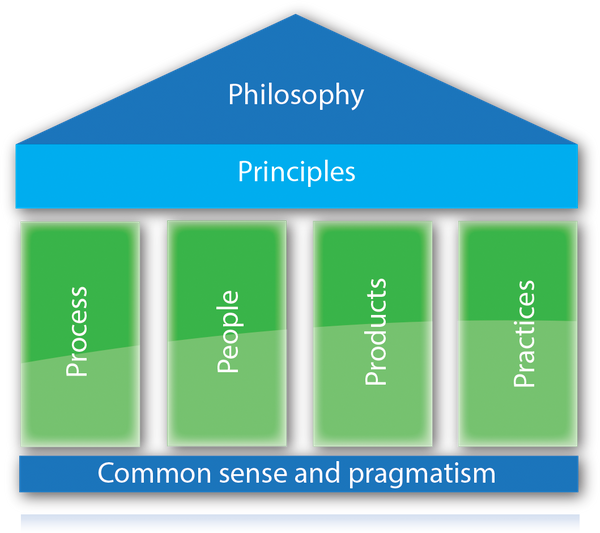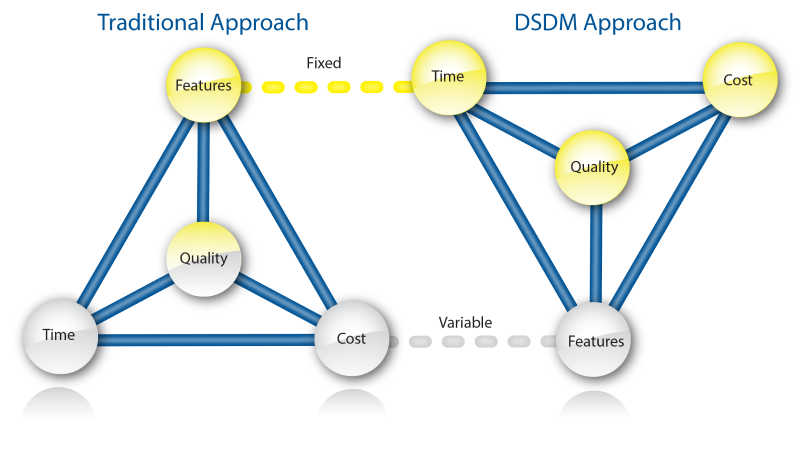Chapter 3: Philosophy Fundamentals
Previous chapter: 2 Choosing DSDM as your Agile Approach
3 Philosophy and Fundamentals
3.1 Introduction
The DSDM philosophy is that
“best business value emerges when projects are aligned to clear business goals, deliver frequently and involve the collaboration of motivated and empowered people.”
This is achieved when all stakeholders:
- Understand and buy into the business vision and objectives
- Are empowered to make decisions within their area of expertise
- Collaborate to deliver a fit for purpose business solution
- Collaborate to deliver to agreed timescales in accordance with business priorities
- Accept that change is inevitable as the understanding of the solution grows over time
- Stakeholders encompass everybody inside or outside the project who are involved in or affected by it.

Figure 3a: The composition of DSDM
The DSDM philosophy is supported by a set of eight principles that build the mindset and behaviours necessary to bring the philosophy alive.The principles are themselves supported by people (with defined roles and responsibilities), an Agile process (enabling an iterative and incremental lifecycle to shape development and delivery), clearly defined products and recommended practices to help achieve the optimum results.
DSDM’s approach and style has always been founded on an underlying ethos of common sense and pragmatism. It may be useful to clarify the meaning of these words:
- Common sense - “sound practical judgment independent of specialised knowledge or training; normal native intelligence.”
- Pragmatism - “action or policy dictated by consideration of the immediate practical consequences rather than by theory or dogma.”
This is the style of thinking that underpins “the way DSDM works”. It is this flexibility of thinking that enables DSDM to avoid the dogmatic thinking that is sometimes encountered in the world of Agile. The ethos of common sense and pragmatism ensures that “individuals and interactions” continue to take precedence over “processes and tools”.
3.2 Expected Project Outcomes using DSDM
Projects embracing the DSDM philosophy, adhering to the principles and following all the guidance associated with the people, process, products and practices will deliver the right solution at the right time for the right cost and will allow the sponsoring business to achieve the benefits that justified the project in the first instance.
It is, however, unrealistic to expect everything within the areas of the business, the solution and the management of the project, to align in such a way as to be perfect for the application of DSDM in its entirety on every project. A pragmatic phrase associated with DSDM since its inception states “While you can use all of DSDM some of the time, you can always use some of DSDM” and it is the fact that DSDM is a flexible framework that allows this to be true.
The following sections in this chapter, and the detail provided in subsequent chapters, assume circumstances which support the application of DSDM. Throughout the handbook, reference is also made to circumstances that are less than ideal.The chapter on tailoring DSDM deals explicitly with some of the most common challenges, using the experience of many DSDM practitioners over many years to show how these challenges have been addressed successfully using DSDM.
3.3 Understanding Project Variables
Projects have to balance conflicting demands, and the four most common demands are: time, cost, features and quality. Trying to fix all four at the outset of a project is unrealistic, as this would only work in a perfect world where the business need never changes, everything is fully and precisely understood in advance, and problems never happen.This desire to fix everything is the cause of many project failures, as the lack of sufficient contingency results in flawed decisions, and these usually affect the project towards the end.
For this reason, it is important at the start of a project to ask the question “If we hit a problem, what do we protect (fix) and what can we negotiate (vary) if necessary?”
 Figure 3b: Project variables – traditional and DSDM
Figure 3b: Project variables – traditional and DSDM
In the traditional approach to managing a project (left-hand diagram), the features content of the solution is fixed whilst time and cost are subject to variation.
If the project goes off track, more resources are often added (which varies the cost) and/or the delivery date extended (which varies the time). However, adding resources to a late project often makes it even later and a missed deadline can be disastrous from a business perspective and often damages credibility. Under such pressure, quality often becomes a variable, as a result of introducing compromises which have not been thought through, by reducing essential quality control steps or by cutting back on testing.
DSDM’s approach to managing the project (right-hand diagram) fixes time, cost and quality at the end of the Foundations phase while contingency is managed by varying the features (the requirements) to be delivered. As and when contingency is required, lower priority requirements are dropped or deferred, with full agreement of the business stakeholders in accordance with MoSCoW priorities.
A DSDM project will always deliver a viable solution, on time and on cost (on budget), as long as the practices of MoSCoW and timeboxing are followed. Delivery of a Minimum Usable SubseT of requirements is guaranteed as a worst case scenario. However, in all but the most extreme circumstances, the expectation is to deliver far more than the bare minimum.
The level of quality for each project depends on the needs of the individual project. Not every project requires “highest quality”, but it does need to achieve the agreed quality level for this project. One of the ways DSDM fixes quality on a project is by agreeing acceptance criteria for individual requirements before development commences. The iterative and incremental approach to development ensures that the more important requirements are built to the agreed level of quality. Only once this has been achieved does development start on the less important requirements. Incremental delivery of the Evolving Solution ensures that, on the day that the solution is deployed into live use, quality is at the level expected and previously agreed.
3.4 DSDM Delivers the Right Solution at the Right Time
3.4.1 Delivery at the right time
DSDM ensures solutions are delivered at the right time by breaking the project down into focused, fixed duration Project Increments, and within these into one or more timeboxes also offixed duration and lasting typically, two to four weeks. In order to protect the agreed end date of an Increment or Timebox, agreement is in place from the start that, if necessary, low priority requirements will be de-scoped.
3.4.2 Delivering the right solution
Using DSDM, the right solution is delivered to the business because:
- The project team and other significant stakeholders remain focused on the business needs
- All people involved with the project work collaboratively to achieve that outcome
- DSDM harnesses the knowledge, experience and creativity of teams to understand the business problem or opportunity, and then to work together to build the optimum solution
- A limited amount of early work ensures firm foundations to support the solution as it grows
- Work is prioritised according to business need and the ability of the business to accommodate changes in the agreed timescale
- An iterative and incremental approach to development and delivery of the solution assures alignment with business need
- Quality is never allowed to become a variable
3.5 Summary
To enable the philosophy of driving out best business value through projects aligned to clear business goals, frequent delivery and collaboration of motivated and empowered people, DSDM offers eight principles, supported by definition of and guidance on people, products, process and practices. All of this guidance needs to be applied with common sense and pragmatism; adapting to the project’s environment and context, while preserving the ethos of DSDM presented here.
